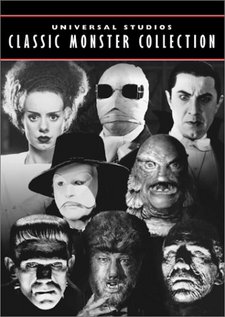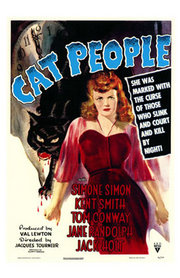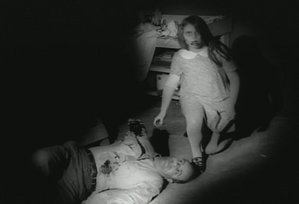Its plots often involve the intrusion of an evil force, event, or personage, sometimes of supernatural origin, into the mundane world.
Some of the most common elements include vampires, zombies (and other forms of resurrected corpses), werewolves, ancient curses, ghosts, demons and/or demonic possession, Satanism, evil children, 'slasher villains', vicious animals, inanimate objects brought to life by black magic or twisted science, haunted houses, cannibals, and malicious extraterrestrials. The serial killer movie is sometimes regarded as part of the horror genre.
Specific stories and characters, often derived from classic literature, have also proven popular, and have inspired many sequels, remakes, and copycats. These include Dracula, Frankenstein, The Mummy, The Wolf Man and Dr. Jekyll and Mr. Hyde.
The horror film is often associated with low budgets and exploitation, but major studios and well-respected directors have made intermittent forays into the genre. The genre's marginal status has caused it to receive much critical dismissal or moral condemnation over the course of film history. However, during the past few decades new generations of critics - more inclined to take popular genres seriously - have given horror substantial attention and analysis, especially with regard to its perceived subversive content. Over the same period, it has become more than ever a source of controversy, as its level of graphic violence has increased and accusations of misogyny have been leveled, especially by feminist critics.
Some horror films owe a substantial amount to other genres, particularly science fiction, fantasy and the thriller. The lines between horror and these other categories are often a subject of debate among fans and critics.
History
Early milestones
The horror genre is nearly as old as film itself. The first depictions of supernatural events appear in several of the silent shorts created by film pioneer Georges Méliès in the late 1890s, most notably in his 1896 Le Manoir du Diable. However, the earliest true 'horror films' were created by German film makers in 1910s and 1920s, many of which were a significant influence on later Hollywood films. Paul Wegener's The Golem (1915) was seminal; in 1920 Robert Wiene's The Cabinet of Dr. Caligari was both controversial with American audiences, due to postwar sentiments, and influential in its Expressionistic style; the most enduring horror film of that era was probably the first vampire-themed feature, F. W. Murnau's Nosferatu (1922), an unauthorized adaptation of Bram Stoker's Dracula.
Early Hollywood dramas dabbled in horror themes, including versions of The Hunchback of Notre Dame (1923) and The Monster (1925) (both starring Lon Chaney, Sr., the first American horror movie star). His most famous role, however, was in The Phantom of the Opera (1925), perhaps the true predecessor of Universal's famous horror series.
1930s & 1940s
It was in the early 1930s that American film producers, particularly Universal Pictures Co. Inc., popularized the horror film, bringing to the screen a series of successful Gothic features including Dracula (1931), and The Mummy (1932), some of which blended science fiction films with Gothic horror, such as James Whale's Frankenstein (1931) and The Invisible Man (1933). These films, while designed to thrill, also incorporated more serious elements, and were influenced by the German expressionism of the 1920s. Some actors began to build entire careers in such films, most notably Boris Karloff and Bela Lugosi.
Other studios of the day had less spectacular success, but Rouben Mamoulian's Dr. Jekyll and Mr. Hyde (Paramount, 1931) and Michael Curtiz's The Mystery of the Wax Museum (Warner Brothers, 1933) were both important horror films.
Universal's horror films continued into the 1940s with The Wolf Man 1941, not the first werewolf film, but certainly the most influential. Throughout the decade Universal also continued to produce more sequels in the Frankenstein series, as well as a number of films teaming up several of their monsters. Also in that decade, Val Lewton would produce a series of influential and atmospheric B-pictures for RKO, including Cat People (1942), I Walked with a Zombie (1943) and The Body Snatcher (1945).
1950s
With the dramatic changes in technology that occurred in the 1950s, the tone of horror films shifted away from the gothic and further toward science fiction. A seemingly endless parade of low-budget productions featured humanity overcoming threats from "outside": alien invasions and deadly mutations to people, plants, and insects. These films provided ample opportunity for audience exploitation, with gimmicks such as 3-D and "Percepto" (producer William Castle's electric-shock technique used for 1959's The Tingler) drawing audiences in week after week for bigger and better scares. The classier horror films of this period, including The Thing From Another World (1951; attributed on screen to Christian Nyby but widely considered to be the work of Howard Hawks) and Don Siegel's Invasion of the Body Snatchers (1956) managed to channel the paranoia of the Cold War into atmospheric creepiness without resorting to direct exploitation of the events of the day. Filmmakers would continue to merge elements of science fiction and horror well into the future.
The late 1950s and early 1960s saw the rise of studios centered specifically around horror. Notable were British production company Hammer Films, which specialized in bloody remakes of classic horror stories often starring Peter Cushing and Christopher Lee, including The Curse of Frankenstein (1957) and Dracula (1958). Hammer, and director Terence Fisher, are widely acknowledged as pioneers of the modern horror movie.
Read more at Wikipedia.org





